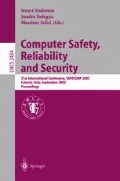Abstract
The paper shows how a model checkable logic of belief and time (MATL) can be used to check properties of security protocols employed in computer networks. In MATL, entities participating to protocols are modeled as concurrent processes able to have beliefs about other entities. The approach is applied to the verification of TLS, the Internet Standard Protocol that IETF derived from the SSL 3.0 of Netscape. The results of our analysis show that the protocol satisfies all the security requirements for which it was designed.
Access this chapter
Tax calculation will be finalised at checkout
Purchases are for personal use only
Preview
Unable to display preview. Download preview PDF.
References
M. Abadi and M. Tuttle. A semantics for a logic of authentication. In Proceedings of the 10th Annual ACM Symposium on Principles of Distributed Computing, pages 201–216, 1991.
M. Benerecetti and A. Cimatti. Symbolic Model Checking for Multi-Agent Systems. In CLIMA-2001, Workshop on Computational Logic in Multi-Agent Systems, 2001. Co-located with ICLP’01.
M. Benerecetti and F. Giunchiglia. Model checking security protocols using a logic of belief. In Proceedings of the 6th International Conference on Tools and Algorithms for the Construction and Analysis of Systems (TACAS 2000), 2000.
M. Benerecetti, F. Giunchiglia, M. Panti, and L. Spalazzi. A Logic of Belief and a Model Checking Algorithm for Security Protocols. In Proceedings of IFIP TC6/WG6.1 International Conference FORTE/PSTV 2000, 2000.
M. Benerecetti, F. Giunchiglia, and L. Serafini. Model Checking Multiagent Systems. Journal of Logic and Computation, 8(3):401–423, 1998.
M. Benerecetti, M. Panti, L. Spalazzi, and S. Tacconi. Verification to Payment Protocols via MultiAgent Model Checking. In Proceedings of the 14th International Conference on Advanced Information Systems Engineering (CAiSE’ 02), 2002.
Michael Burrows, Martin Abadi, and Roger Needham. A logic of authentication. ACM Transactions on Computer Systems, 8(1):18–36, feb 1990.
T. Dierks and C. Allen. The TLS Protocol Version 1.0. IETF RFC 2246, 1999.
E.A. Emerson. Temporal and Modal Logic. In Handbook of Theoretical Computer Science, volume B, pages 996–1072, 1990.
A. Frier, P. Karlton, and P. Kocher. The SSL 3.0 Protocol. Netscape Communications Corp., 1996.
G. Lowe. Finite-State Analysis of SSL 3.0. In Proceedings of the 4th Conference Tools and Algorithms for the Construction and Analysis of Systems, pages 147–166, 1996.
S. Lu and S.A. Smolka. Model Checking the Secure Electronic Transaction (SET) Protocol. In Proceedings of 7 th International Symposium on Modeling, Analysis and Simulation of Computer and Telecommunication Systems, pages 358–365. IEEE Computer Society, 1999.
W. Marrero, E. Clarke, and S. Jha. Model Checking for Security Protocols. In Proceedings of the DIMACS Workshop on Design and Formal Verification of Security Protocols, 1997.
C. Mitchell, V. Shmatikov, and U. Stern. Finite-State Analysis of SSL 3.0. In Proceedings of the 7th USENIX Security Symposium, pages 201–216, 1998.
L.C. Paulson. Inductive Analysis of the Internet Protocol TLS. ACM Transactions on Computer and System Security, 2(3):332–351, 1999.
P. Syverson and P.C. van Oorschot. On Unifying Some Cryptographic Protocol Logics. In Proceedings of the IEEE Symposium on Research in Security and Privacy, pages 14–28, 1994.
D. Wagner and B. Schneier. Analysis of the SSL 3.0 Protocol. In Proceedings of the 2nd USENIX Workshop on Electronic Commerce Proceedings, pages 29–40, 1996.
Author information
Authors and Affiliations
Editor information
Editors and Affiliations
Rights and permissions
Copyright information
© 2002 Springer-Verlag Berlin Heidelberg
About this paper
Cite this paper
Benerecetti, M., Panti, M., Spalazzi, L., Tacconi, S. (2002). Verification of the SSL/TLS Protocol Using a Model Checkable Logic of Belief and Time. In: Anderson, S., Felici, M., Bologna, S. (eds) Computer Safety, Reliability and Security. SAFECOMP 2002. Lecture Notes in Computer Science, vol 2434. Springer, Berlin, Heidelberg. https://doi.org/10.1007/3-540-45732-1_14
Download citation
DOI: https://doi.org/10.1007/3-540-45732-1_14
Published:
Publisher Name: Springer, Berlin, Heidelberg
Print ISBN: 978-3-540-44157-1
Online ISBN: 978-3-540-45732-9
eBook Packages: Springer Book Archive

